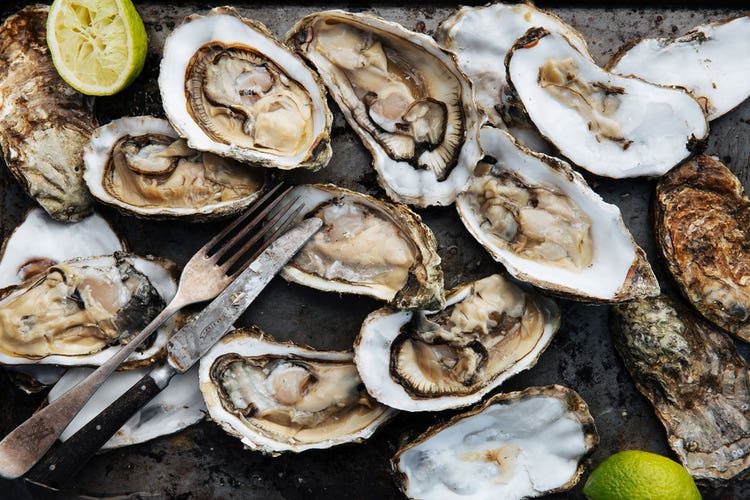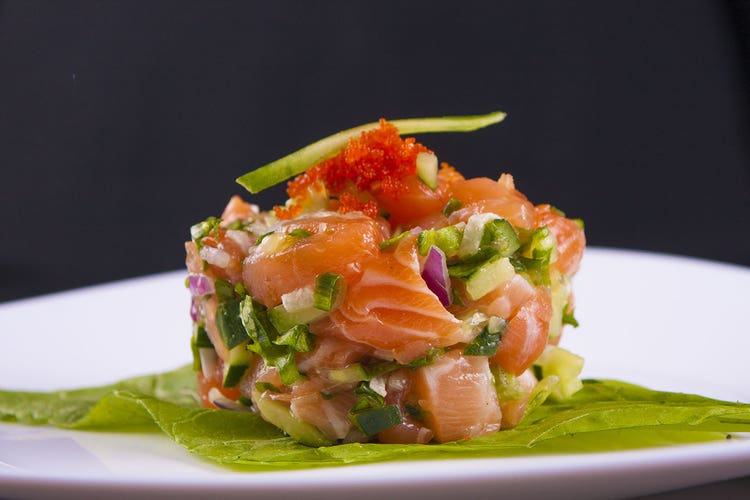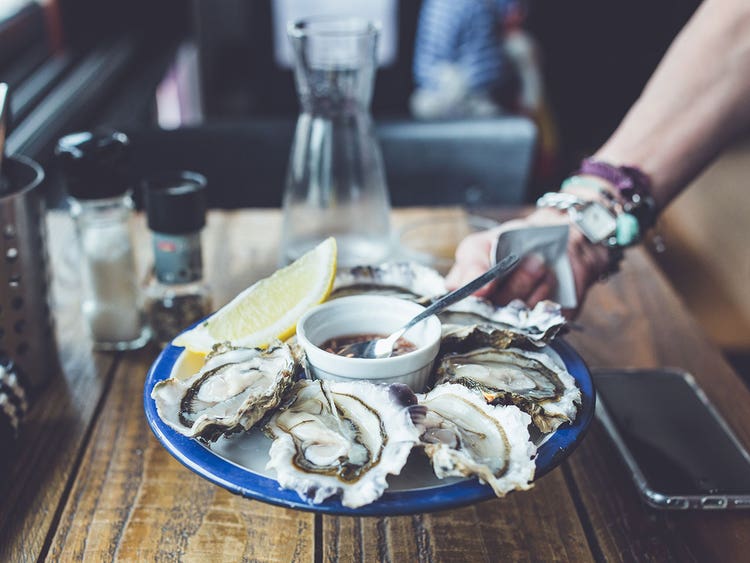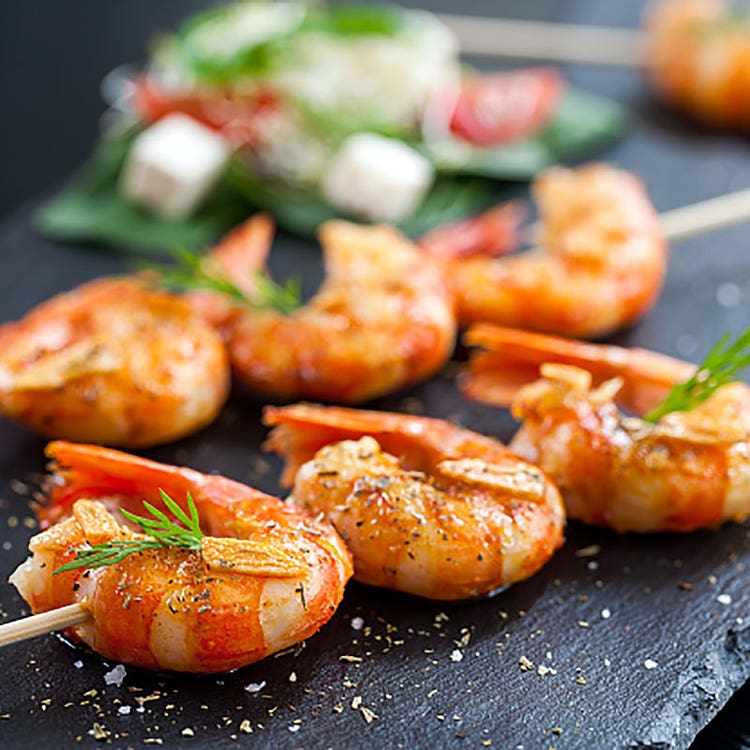Victory on Ice

Try this raw bar celebration.
Glittering crushed ice, scattered with brooch-like shellfish, and bowls of bright, bracing condiments. Elegant and opulent, no food presentation trumps the raw bar. On the pricey side, it’s the ultimate way to celebrate the Olympic Winter Games—or any other win.
Fortunately, assembling a raw bar is relatively easy—and healthy. After all, seafood is rich in lean protein and omega-3 fatty acids. Plus, most raw bar preparations (such as the vinegar-based mignonette sauce for raw oysters) rely on acidic ingredients rather than fat or sugar.
For your own raw bar, consider including poke (such as the shoyu ahi poke from Martha Cheng, author of “The Poke Cookbook,” recipe below). Pronounced poh-KAY, this traditional Hawaiian dish stars cubed and marinated meat or seafood, usually raw tuna. “The freshest fish makes for the best poke,” Cheng says. Although she prefers fresh ahi tuna, Cheng also uses previously frozen salmon or (more economical) cooked shrimp. She also recommends tofu, tomatoes and cooked beets for vegetarian versions.
To prepare it, Cheng counsels, wield a sharp knife when cutting the fish, and use only a few ingredients. “For a party, I’d set up a poke bar and nest each bowl in a larger bowl of ice to keep the fish cool,” she says.
Raw in the Southern Hemisphere

A Latin American version of poke, ceviche (such as the ceviche Andina recipe from Martin Morales, author of “Andina: The Heart of Peruvian Food”) consists of raw seafood marinated in fresh lime juice or another acid. Morales recommends opting for sustainable, fresh, sashimi-grade whitefish (such as sea bass or sea bream), scallops or raw prawns. For best results, he suggests plucking all bones from the fish, balancing the acidic marinade with enough salt, serving in a transparent, relatively flat dish, and preparing right before serving.
When he whips up ceviche, Barton Seaver, author of “Two if by Sea,” balances fresh herbs with red chili pepper in the marinade and adds texture via apple, endive, radicchio or frisee. As a garnish, Seaver will use sweet potato (pre-boiled with orange zest and thyme).
To many, the most striking feature of a raw bar is oysters on the half shell. “For an at-home ‘oyster bar’ experience, shucking at home is really the only way to go,” says Cynthia Nims, author of “Oysters.” To open those shells, she explains that “you’ll need a special oyster shucking knife, with a very sturdy, tapered blade—not a kitchen knife. … Equally important is protection for your hand, whether it’s the layers of a folded thick kitchen towel or a special oyster-shucking glove.” Consider hiring a shucker, if you’re intimidated.
To source the freshest live specimens in the shell, Nims recommends “a specialty seafood market, upscale grocer with a full-service seafood counter or an Asian grocer with a bustling seafood department.” Oysters should be “stored in live tanks or on plenty of ice. … Shells should be tightly closed and sound firm—like a rock—rather than hollow when tapped together,” she says. Nims also suggests ordering oysters shipped directly from a grower, such as Taylor Shellfish Farms and Hama Hama Oysters, so “they’ll arrive a day or two out of the water and be in prime condition for your party.”
Preparation and presentation

Varietywise, in general, Nims summarizes that “East Coast oysters tend to have a straight-on briny character, while West Coast oysters can have a little more complexity, with mineral, vegetal notes.” Seaver describes Southern oysters (from south of the Chesapeake Bay and throughout the Gulf of Mexico) as featuring “a softer texture and less brine.”
For the presentation, choose a serving dish broad enough to hold a dozen or two oysters, with ¾- to 1-inch-deep edges (for holding ice and the water that accumulates). In a pinch, Nims admits that you can “just use your largest rimmed baking sheet or a few rimmed dinner plates and dress up the display with extra wedges of lemon or fresh herb sprigs.”
To gild the lily, don’t forget the accompanying sauces, such as Nims’ kimchi-cucumber relish or Seaver’s West Coast mignonette. (See recipes below.) “Raw shellfish has a long tradition of accompaniments, including cocktail sauce, lemon juice, horseradish and the French sauce known as mignonette,” Seaver says. “Mignonette is a mixture of vinegar and water flavored with freshly diced shallot and peppercorn. The peppery bite, sweet shallot and bright acidity of the vinegar enlivens oysters, especially those that are super briny and need a bit of balance.”
Cooked counts, too

Although technically cooked, chilled shrimp, crab and lobster are a mainstay of most raw bars—and your guests will likely expect them. Since shells help to protect the meat, keeping it moist while adding flavor, shellfish (unlike more delicate fish) can stand up to boiling. Seaver recommends purchasing wild-caught U.S. shrimp (or farmed, as a backup), and he points out that king crab legs are almost always available frozen and precooked.
To boil shrimp, other forms of crab or lobster, he advises adding enough (heavily salted) water to a large pot to cover half the shellfish. Then add the crustaceans (in their shells) and cover. When the water returns to a boil, cook; if preparing a large quantity, boil in batches.
Cook small (21 to 25 count) shrimp for two to four minutes, medium (16 to 20 count) for three to five minutes and large (10 to 15 count) for four to six minutes. Then turn off the heat and let rest in the water for five more minutes. Depending on size, boil raw crab for 10 to 20 minutes and lobster for seven to 14 minutes (seven minutes for 1 pound to 14 minutes for 2½ pounds).
Once cooked, chill and serve with Seaver’s zingy cocktail sauce (recipe below) over ice.
In fact, for all raw bar preparations, you’ll need ample crushed ice. Not only will it keep the seafood cold—it will also prop the shellfish up, preventing their delicious juices from escaping. To prepare crushed ice, Seaver suggests wrapping ice cubes in a towel, beating with a wooden rolling pin (until the ice is mostly crushed), and then transferring it to a platter immediately (before it melts).
Finally, don’t forget a mineral-rich, crisp white wine (such as Sancerre), Champagne or even beer for pairing. Cheers!
RAW BAR RECIPES
Shoyu Ahi Poke
This is the classic poke, the one that you probably think of when you hear the word. … At popular poke counters, you’ll find this base mixed with all sorts of seafood, such as salmon, blue marlin or abalone, and even non-seafood like tomatoes or edamame.
Serves 4
Ingredients:
- 1 pound sushi-grade tuna, cut into ¾-inch pieces
- ½ cup thinly sliced yellow onions
- ½ cup thinly sliced scallions (green parts only)
- 2 tablespoons soy sauce, plus more to taste
- 1 teaspoon toasted sesame oil
- ½ teaspoon sambal oelek
Directions:
In a medium bowl, combine all the ingredients. Fold gently until evenly distributed. Taste and adjust with more soy sauce as desired.
Serve immediately, or cover tightly and refrigerate for up to a day. If you let the poke marinate, taste it again right before serving; you may want to add another splash of soy sauce.
*Reprinted from “The Poke Cookbook.” Copyright © 2017 by Martha Cheng. Photographs copyright © 2017 by Aubrie Pick. Published by Clarkson Potter/Publishers, an imprint of Penguin Random House LLC.
Ceviche Andina (Sea Bass and Avocado Ceviche)
This is one of our most iconic dishes at [Morales’ restaurant], Andina. Although associated with the coast, in fact ceviches are eaten all over Peru, especially in the Andes where there is a wide variety of river fish. In this recipe, we have brought together some key Andina ingredients to create a ceviche that sings with authenticity.
Serves 4
Ingredients:
For the marinade:
- ¼-inch piece of ginger
- 1 garlic clove, halved
- 4 cilantro sprigs
- Juice of 12 limes, plus extra to taste
- 2 tsp. chili paste
For the cilantro oil:
- 5 cilantro sprigs
- 5 tbsp. olive oil
- For the ceviche garnishes and fish
- 1 large red onion, very thinly sliced
- 1 sweet potato, peeled and cut into ½-inch dice
- 2 1-oz. skinless sea bass fillets, cut into ½-inch dice
- A few cilantro leaves, finely chopped; plus a few extra whole leaves, to decorate
- 1 large, ripe avocado, pitted, and flesh cut into ½-inch dice
- 12 mandarin oranges or tangerines, halved
- 2 tsp. pistachios, crushed, to serve
- Salt
Directions:
First, make the marinade: Put the ginger, garlic, cilantro and lime juice in a bowl. Stir and leave to infuse for 10 minutes. Strain the mixture through a sieve into a separate bowl and add the chili paste and ½ teaspoon of salt. Taste to check the balance of flavors and add more salt, chili or lime juice if necessary. Set aside.
Next, make the cilantro oil by blitzing the ingredients together with a stick blender. Set aside. (You can store any unused herb oil in a sterilized jar for up to 4 weeks.)
Third, make the garnishes for the fish: Meanwhile, soak the onion slices in iced water for 5 minutes, then drain them thoroughly and lay them out on kitchen paper so that they dry completely. Bring a small saucepan of water to the boil. Salt the water, then add the sweet potato cubes. Reduce the heat to low and simmer until just tender (about 5-7 minutes). Drain and set aside.
Finally, assemble the ceviche: Put the cubes of sea bass in the bowl with the marinade for 1 minute only, then add the onion slices, chopped cilantro, avocado, tangerine, and the cooked sweet potato. Turn all the components over very gently (you do not want the sweet potato or avocado to break up), then divide the ceviche equally between 4 bowls. Taste and check the seasoning, adding a little more salt if necessary, then serve immediately decorated with a sprinkling of pistachios, cilantro leaves, and cilantro oil.
*(Adapted) recipe excerpted with permission from “Andina: The Heart of Peruvian Food” by Martin Morales, published by Quadrille, November 2017.
Kimchi-Cucumber Relish
Kimchi—traditional Korean fermented vegetables, often cabbage—brings bold, spicy flavor to whatever context in which it’s served. Its character is tempered a bit with a bright, crisp complement from cucumber. If you’re a big fan of kimchi, feel free to amend the proportions, using a half cup each of the cucumber and kimchi. As is, this offers a milder kimchi flavor that most oyster slurpers should enjoy.
Makes 1 cup, enough for about 4 dozen half-shell oysters
Ingredients:
- ¾ cup peeled and seeded finely chopped cucumber
- ¼ cup finely chopped kimchi
- 1 teaspoon unseasoned rice vinegar, plus more to taste
- ¼ teaspoon soy sauce, plus more to taste (optional)
Directions:
In a small bowl, stir together the cucumber, kimchi, rice vinegar, and soy sauce. Taste for seasoning, adding a bit more vinegar or soy sauce to taste. Let the relish sit for about 30 minutes, stirring occasionally, to allow the flavors to blend.
Transfer the relish to a small ramekin or other small serving dish and refrigerate until ready to serve, up to 1 hour.
*(c)2016 By Cynthia Nims. All rights reserved. Excerpted from “Oysters: Recipes That Bring Home a Taste of the Sea” by permission of Sasquatch Books. Photography by Jim Henkens.
Spicy West Coast Mignonette
Makes enough for 1 to 2 dozen oysters
Ingredients:
- 2 tablespoons minced shallot, rinsed briefly under cold water
- 3 to 5 thin slices medium-spicy fresh chili pepper, such as Fresno or serrano
- 3 thin slices fresh ginger
- Pinch ground black pepper
- Pinch ground allspice
- Salt
- 3 tablespoons red wine vinegar
- A few drops freshly squeezed lime juice
- 1 tablespoon finely chopped fresh cilantro
- 1½ teaspoons chopped fresh tarragon
- 1 tablespoon water
Directions:
Combine the shallots, chili pepper, ginger, pepper, allspice, and a pinch of salt with the vinegar and lime juice. Allow the mixture to sit for at least 10 minutes.
Before serving, remove the ginger and chili pepper. Stir in the cilantro and tarragon and add the water to balance the acidity of the sauce. Serve alongside freshly shucked oysters and spoon over them just prior to eating. Use the sauce within two hours.
*Reprinted with permission from “Two if by Sea” © 2016 by Barton Seaver, Sterling Epicure, an imprint of Sterling Publishing Co. Inc. Photography by Michael Piazza
Cocktail Sauce
Makes about ¾ cup
This kicky sauce is delicious with poached shellfish or fried seafood of any kind.
Ingredients:
- ½ cup chili sauce
- 1 tablespoon prepared horseradish
- 2 teaspoons Worcestershire sauce
- 2 teaspoons vinegar-based hot sauce
- Pinch of salt
Directions:
Stir all ingredients to combine. The cocktail sauce keeps for up to five days in the refrigerator.
*Reprinted with permission from “Two if by Sea” © 2016 by Barton Seaver, Sterling Epicure, an imprint of Sterling Publishing Co. Inc. Photography by Michael Piazza
Photo credit: Pietro Karras, Stocksy; barkstudio, Adobe Stock; Sweet Ice Cream Photography, Unsplash; karelnoppe, Adobe Stock